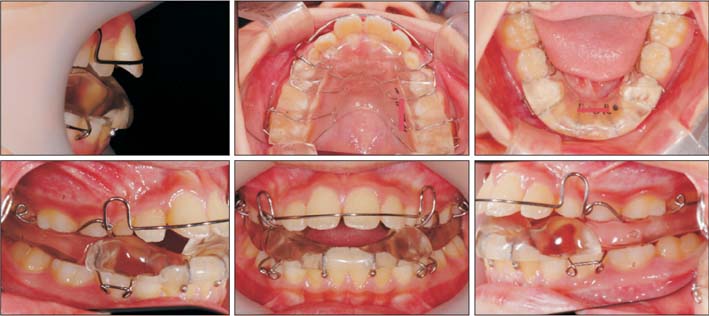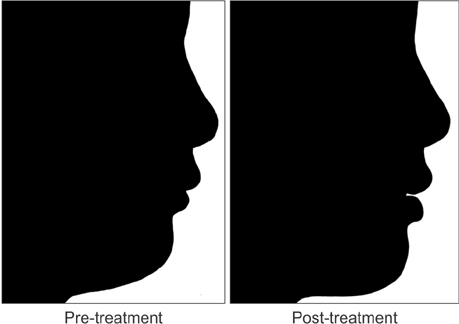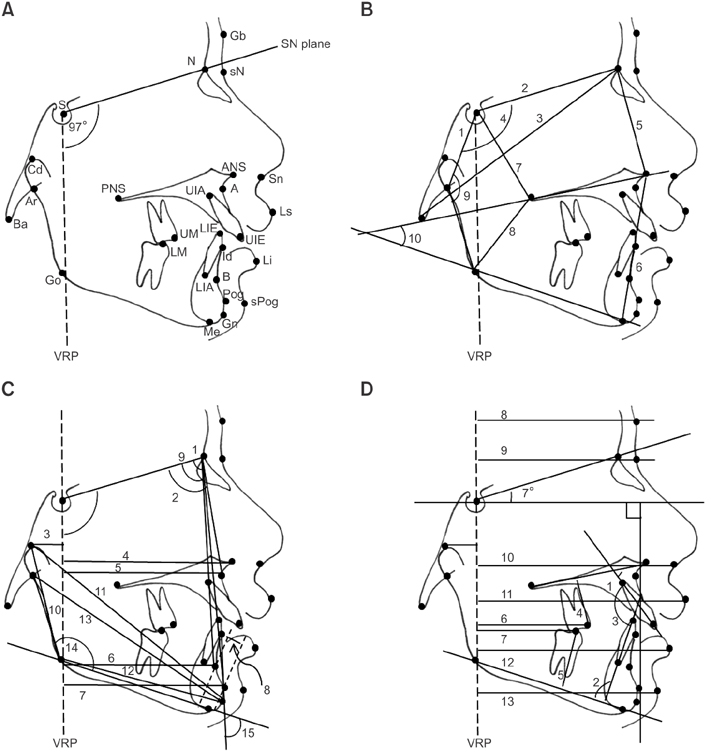Korean J Orthod.
2018 Jan;48(1):11-22. 10.4041/kjod.2018.48.1.11.
Predictors of favorable soft tissue profile outcomes following Class II Twin-block treatment
- Affiliations
-
- 1Department of Orthodontics, College of Dentistry, Kyung Hee University, Seoul, Korea. deodor94@khu.ac.kr
- 2Department of Orthodontics, Dental Hospital, Kyung Hee University Hospital at Gangdong, Seoul, Korea.
- 3Department of Orthodontics, College of Dentistry, Seoul National University, Seoul, Korea.
- KMID: 2441437
- DOI: http://doi.org/10.4041/kjod.2018.48.1.11
Abstract
OBJECTIVE
The aim of this study was to determine cephalometric factors that help predict favorable soft-tissue profile outcomes following treatment with the Class II Twin-block appliance.
METHODS
Pre- and post-treatment lateral cephalograms of 45 patients treated with the Class II Twin-block appliance were retrospectively analyzed. Profile silhouettes were drawn from the cephalograms and evaluated by three orthodontists in order to determine the extent of improvement. Samples were divided into a favorable group (upper 30% of visual analogue scale [VAS] scores, n = 14) and an unfavorable group (lower 30% of VAS scores, n = 14). Skeletal and soft-tissue measurements were performed on the cephalograms and an intergroup comparison was conducted.
RESULTS
An independent t-test revealed that the following pre-treatment values were lower in the favorable group compared to the unfavorable group: lower incisor to mandibular plane angle, lower incisor to pogonion distance, point A-nasion-point B angle, sella-nasion line (SN) to maxillary plane angle, SN to mandibular plane angle, gonial angle, and symphysis inclination. The favorable group had a larger incisor inclination to occlusal plane. Moreover, the favorable group showed larger post-treatment changes in gonial angle, B point projection, and pogonion projection than did the unfavorable group.
CONCLUSIONS
Class II malocclusion patients with a low divergent skeletal pattern and reduced lower incisor protrusions are likely to show more improvement in soft-tissue profile outcomes following Class II Twin-block treatment.
Figure
Reference
-
1. Cacciatore G, Alvetro L, Defraia E, Ghislanzoni LT, Franchi L. Active-treatment effects of the Forsus fatigue resistant device during comprehensive Class II correction in growing patients. Korean J Orthod. 2014; 44:136–142.
Article2. Han S, Choi YJ, Chung CJ, Kim JY, Kim KH. Long-term pharyngeal airway changes after bionator treatment in adolescents with skeletal Class II malocclusions. Korean J Orthod. 2014; 44:13–19.
Article3. Cozza P, Baccetti T, Franchi L, De Toffol L, McNamara JA Jr. Mandibular changes produced by functional appliances in Class II malocclusion: a systematic review. Am J Orthod Dentofacial Orthop. 2006; 129:599.e1–599.e12. discussion e1-6.
Article4. Davidenko N. Silhouetted face profiles: a new methodology for face perception research. J Vis. 2007; 7:6.
Article5. Singh GD, Clark WJ. Soft tissue changes in patients with Class II Division 1 malocclusions treated using Twin Block appliances: finite-element scaling analysis. Eur J Orthod. 2003; 25:225–230.
Article6. Baysal A, Uysal T. Soft tissue effects of Twin Block and Herbst appliances in patients with Class II division 1 mandibular retrognathy. Eur J Orthod. 2013; 35:71–81.
Article7. Baysal A, Uysal T. Dentoskeletal effects of Twin Block and Herbst appliances in patients with Class II division 1 mandibular retrognathy. Eur J Orthod. 2014; 36:164–172.
Article8. Quintão C, Helena I, Brunharo VP, Menezes RC, Almeida MA. Soft tissue facial profile changes following functional appliance therapy. Eur J Orthod. 2006; 28:35–41.
Article9. Vargervik K, Harvold EP. Response to activator treatment in Class II malocclusions. Am J Orthod. 1985; 88:242–251.
Article10. Barton S, Cook PA. Predicting functional appliance treatment outcome in Class II malocclusions--a review. Am J Orthod Dentofacial Orthop. 1997; 112:282–286.
Article11. Caldwell S, Cook P. Predicting the outcome of twin block functional appliance treatment: a prospective study. Eur J Orthod. 1999; 21:533–539.
Article12. Franchi L, Baccetti T. Prediction of individual mandibular changes induced by functional jaw orthopedics followed by fixed appliances in Class II patients. Angle Orthod. 2006; 76:950–954.
Article13. Toureno L, Kook YA, Bayome M, Park JH. The effect of western adaptation of Hispanic-Americans on their assessment of Korean facial profiles. Korean J Orthod. 2014; 44:28–35.
Article14. Patel HP, Moseley HC, Noar JH. Cephalometric determinants of successful functional appliance therapy. Angle Orthod. 2002; 72:410–417.15. Björk A. Prediction of mandibular growth rotation. Am J Orthod. 1969; 55:585–599.
Article16. Tulley WJ. The scope and limitations of treatment with the activator. Am J Orthod. 1972; 61:562–577.
Article17. Pancherz H. The mandibular plane angle in activator treatment. Angle Orthod. 1979; 49:11–20.18. Ahlgren J, Laurin C. Late results of activatortreatment: a cephalometric study. Br J Orthod. 1976; 3:181–187.
Article19. Parkhouse RC. A cephalometric appraisal of cases of Angle's Class II, Division I malocclusion treated by the Andresen appliance. Dent Pract Dent Rec. 1969; 19:425–433.20. Sharma AA, Lee RT. Prospective clinical trial comparing the effects of conventional Twin-block and mini-block appliances: Part 2. Soft tissue changes. Am J Orthod Dentofacial Orthop. 2005; 127:473–482.
Article21. Mills CM, McCulloch KJ. Treatment effects of the twin block appliance: a cephalometric study. Am J Orthod Dentofacial Orthop. 1998; 114:15–24.
Article22. Nelson C, Harkness M, Herbison P. Mandibular changes during functional appliance treatment. Am J Orthod Dentofacial Orthop. 1993; 104:153–161.
Article23. Sharma AK, Sachdev V, Singla A, Kirtaniya BC. Skeletal and dentoalveolar changes concurrent to use of Twin Block appliance in class II division I cases with a deficient mandible: a cephalometric study. J Indian Soc Pedod Prev Dent. 2012; 30:218–226.
Article24. O'Brien K, Wright J, Conboy F, Appelbe P, Davies L, Connolly I, et al. Early treatment for Class II Division 1 malocclusion with the Twin-block appliance: a multi-center, randomized, controlled trial. Am J Orthod Dentofacial Orthop. 2009; 135:573–579.
- Full Text Links
- Actions
-
Cited
- CITED
-
- Close
- Share
- Similar articles
-
- A cephalometric study on the soft tissue profile changes by orthodontic treatment in female patients
- A study on the variations of the soft tissue profile contour in relation to the skeletal patterns
- Cephalometric analysis of skeletal Class II malocclusion in Korean adults
- A roentgenocephalometric study on soft tissue profile changes in pre-post treatment of Angle's Class II division I malocclusion
- Facial soft tissue thickness among skeletal malocclusions: is there a difference?




